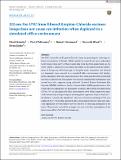222 nm Far-UVC from filtered Krypton-Chloride excimer lamps does not cause eye irritation when deployed in a simulated office environment
Abstract
Far-UVC, from filtered Krypton-Chloride lamps, is promising for reducing airborne transmission of disease. Whilst significant research has been undertaken to investigate skin safety of these lamps, less work has been undertaken on eye safety. There is limited data on human eye safety or discomfort from the deployment of this germicidal technology. In this pilot study, immediate and delayed eye discomfort were assessed in a simulated office environment with deployment of Krypton-Chloride lamps, located on the ceiling and directed downwards into the occupied room. Discomfort was assessed immediately post-exposure and several days after exposure using validated, Standard Patient Evaluation Eye Dryness (SPEED) and Ocular Surface Disease Index (OSDI) questionnaires. Our results show no significant eye discomfort or adverse effects from the deployment of Far-UVC in this simulated office environment, even when lamps were operated continuously with participants receiving head exposures of up to 50 mJ cm-2 . In addition, a statistically significant reduction in bacteria and fungi of 52% was observed. Far-UVC in this simulated office environment did not cause any clinically significant eye discomfort and was effective at reducing pathogens in the room. These results contribute an important step to further investigation of the interaction of Far-UVC with the human eye.
Citation
Kousha , O , O’Mahoney , P , Hammond , R , Wood , K & Eadie , E 2024 , ' 222 nm Far-UVC from filtered Krypton-Chloride excimer lamps does not cause eye irritation when deployed in a simulated office environment ' , Photochemistry and Photobiology , vol. 100 , no. 1 , pp. 137-145 . https://doi.org/10.1111/php.13805
Publication
Photochemistry and Photobiology
Status
Peer reviewed
ISSN
0031-8655Type
Journal article
Description
Funding: This work was funded by the Science and Technology Facilities Council (STFC) Impact Accelerator Account (IAA) at the University of St Andrews.Collections
Items in the St Andrews Research Repository are protected by copyright, with all rights reserved, unless otherwise indicated.

